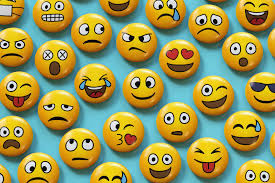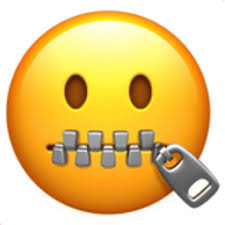EMOJI STATUTARY CONSTRUCTION
“EMOJI STATUTARY CONSTRUCTION”
Emoji has been derived from the Japanese word meaning “picture character”. Oxford dictionary defines Emoji as a “small digital image or an icon used to express an idea, emotion etc. in electronic communication”. Unlike plain text where people view the same character in their exchange platforms effectively translate Emoji. The Emoji that a sender chooses is translated to the receiver’s platform rendering since Emoji renders differently on different platforms. The emoji graphic that is send by one person on one device may be quite different than what is seen by the recipient using a different device.

Non-Unicode Emojis are usually not compatible across multi-level platforms, so the recipient on the other platforms will see a placeholder symbol replacing a non-Unicode Emoji or nothing at all.
JUDICIAL INTERPRETATION OF EMOJI-
VISUAL DECODING-this brings us to the question of visual decoding, very often the small size of Emoji makes them difficult to decode as many a times subtle differences are difficult to distinguish, mistaken decoding can lead to misinterpretation.
SYMBOLS MAY HAVE MULTIPLE MEANINGS – Similarly, many symbols may have multiple meanings which may add ambiguity to the messages which can be interpreted in several ways e.g. folded hands Emoji convey thank you or I am praying. This poses a special problem because there is no definitive reference source catalogue. Though Unicode provides a short description of every Emoji but at the same time it acknowledges that it may not encompass all the possible meanings.
CULTURAL DIFFERENCE –Then again if there is a cultural difference between the sender and the recipient misunderstandings are likely to follow.
Proper Emoji evidence is before the interpreter then the whole matter becomes a part of applicable substantive law.
Over a period of time Emoji’s usage has increased many fold, it is away to express ourselves. Though it is a general perception that Emoji’s are for the sake of fun and are cute in nature but there usage are leading to misunderstanding in legal interpretation for example whether someone is liable for Sexual Harassment or obligated by Contract.
We all are witness to the fact that our legal system has evolved substantially in interpreting new forms of contents. Those it holds true to handle Emoji’s or it means extra interpretive challenges.
Over the ages we are also witness to the fact that the mode of communication evolved with technological advancement, the symbols of communications which serve as visual representation to express any information, emotions or ideas.
In the recent times Emoji’s has led to legal disputes and had to be interpreted based on various interpretation in different jurisdictions.
INTERNATIONAL PRESPECTIVE ON THE USAGE OF EMOJI
CANADA:
 South West Terminal Ltd. Vs. ACHTER Land and Cattle Ltd. – The Court was concerned with the question of whether there was a valid Contract between the buyer and the seller. The buyer subsequent to a conversation on mobile sign the Contract and then took a photo of it using his cell phone and send it to the seller with the message “ Please confirm FLAX Contract” the Seller texted back a “Thumps Up”( 👍 ). It was contented on behalf of the seller that the Emoji meant a sort of acknowledgement of receiving the message while the purchaser said it was meant to be for the affirmation of the Contract.
South West Terminal Ltd. Vs. ACHTER Land and Cattle Ltd. – The Court was concerned with the question of whether there was a valid Contract between the buyer and the seller. The buyer subsequent to a conversation on mobile sign the Contract and then took a photo of it using his cell phone and send it to the seller with the message “ Please confirm FLAX Contract” the Seller texted back a “Thumps Up”( 👍 ). It was contented on behalf of the seller that the Emoji meant a sort of acknowledgement of receiving the message while the purchaser said it was meant to be for the affirmation of the Contract.
While adjudicating the case Justice “Keene” looked in to the dictionary for the meaning of “Thumps up” ( 👍 ), -it is used to express assent, approval or engagement in digital communication and the court found that there was consensuses-ad-idem between the buyer and the seller and that the Contract was enforceable. The seller was asked to pay damages for the Breach of the Contract.
U.S.A
Emoji’s are increasingly appearing in criminal cases in U.S.A. and there use can significantly impact how evidence is interpreted and understood. In the Trial of Ross Ulvriched the founder of silk road online market place was convicted of Money Laundering , Computer Hacking and Conspiracy in this case all internet communications including Emoji’s was considered by the Jury while deliberating the intention of the accused. So the Emoji’s can be submitted as evidence in the court with their admissibility to contingent on relevance to the case and their accuracy of their interpretation within the communication context.
FRANCE:
 Azougagh Bilal was convicted for making criminal threats by sending a gun shaped character to his Ex-Girlfriend through a text message sent from his Mobile Number the court found that the the message constituted a death threat in the form of an image which determines his intent Men’s-Rea .He was sentence to 6 months of imprisonment and a 1000 Euro fine.
Azougagh Bilal was convicted for making criminal threats by sending a gun shaped character to his Ex-Girlfriend through a text message sent from his Mobile Number the court found that the the message constituted a death threat in the form of an image which determines his intent Men’s-Rea .He was sentence to 6 months of imprisonment and a 1000 Euro fine.
ISRAELI:
 Dahan Versus Shakaroff.-The Judge observed that the positive Emoji’s which included a smiley face(J), a bottle of champagne, Dancing figure indicated and intent to do business and awarded damages to the land lord.
Dahan Versus Shakaroff.-The Judge observed that the positive Emoji’s which included a smiley face(J), a bottle of champagne, Dancing figure indicated and intent to do business and awarded damages to the land lord.
AUSTRALIA:
 In Burrows Vs Houda, Houda a Lawyer reposted a tweet about an another Lawyer Burrow, the plaintiff who was facing disciplinary action from the Law Society due to alleged misconduct. The inclusion of the Zipper mouth was held to be defamatory. The Judge relaying on online dictionary Emoji-pedia said that in meant a ‘secret’, ‘Stop talking’ the court observed the post was easily accessible to the Twitter user which would result in considerable harm to Burrows reputation which would affect her carrier as a Lawyer.
In Burrows Vs Houda, Houda a Lawyer reposted a tweet about an another Lawyer Burrow, the plaintiff who was facing disciplinary action from the Law Society due to alleged misconduct. The inclusion of the Zipper mouth was held to be defamatory. The Judge relaying on online dictionary Emoji-pedia said that in meant a ‘secret’, ‘Stop talking’ the court observed the post was easily accessible to the Twitter user which would result in considerable harm to Burrows reputation which would affect her carrier as a Lawyer.
INDIA:
Director General, Railway Protection Force Vs. Narendra Chauhan. In this Narendra Chauhan was an employee of the Central Railway Protection Special Force was dismissed from service for putting a “thums up” ( 👍 ) as a reply to a message in a WhatsApp group were a video of a constable murdering the assistant commander was shared. This was construed as he was giving a morale support to the accused and was celebrating the Murder. Disciplinary proceeding was conducted and he was removed from service over his Emoji remark. The division bench of the Madurai bench of Madras High Court considered the “thums up” ( 👍 ) Emoji to be construct to be an alternative to the word “OK” it further said that sharing of Emoji Symbol did not amount to celebrating the Murder but an acknowledgment of the fact that he had seen the message and thus was directed to be restated in his Service.
 In I. Linga Bhaskar Vs The State of Tamil Nadu.– an official WhatsApp Group was created to share complaints and grievances in the deficiency of services in BSNL and to rectify them. A video was posted by a complainant (an outdoor staff of BSNL) containing three customers complaining about the services of the BSNL. The accused (Indoor Staff) assumed the video was taking to de-grade them and in response all the Indoor staff posted 🤣 Emoji and retaliation for that humiliation.
In I. Linga Bhaskar Vs The State of Tamil Nadu.– an official WhatsApp Group was created to share complaints and grievances in the deficiency of services in BSNL and to rectify them. A video was posted by a complainant (an outdoor staff of BSNL) containing three customers complaining about the services of the BSNL. The accused (Indoor Staff) assumed the video was taking to de-grade them and in response all the Indoor staff posted 🤣 Emoji and retaliation for that humiliation.
The complainant stated that she was put to mental agony and was crying whole night and could not sleep. The complaint was registered under Tamil Nadu Prohibition of Harassment of Women Act, SC and St’s (prevention of Atrocities) Act section 67 of the IT Act. Challenging the FIR, a Quash Petition was filed before the Hon’ble Madras High Court. It observed that an Emoji is sent to express once felling about something and cannot be treated as overt act on others and thus quash the complaint.
Though ambiguous, Emoji’s do convey meaning and the Lawyers need to considered whether they would be legally binding or convey intent.

Emoji’s have Multitude Meanings:
though Emoji’s may have many meaning but it primarily depends on their context, For E.g. a Winky Face could indicate Flirting, Teasing, Joking or Sarcasm. Context can be drawn from the immediate message, the Senders and the Receivers Personal History or wider cultural context.
Emoji’s Disciplinary between Platforms: Most Emoji’s are conveyed using a Universal code called Unicode. This is interpreted by different platforms differently. Unicode defined each Emoji’s with a ‘Suggested’ outline Image and a brief description. The Emoji’s conveyed using a code but when the other platform receives that code it presents it on interpretation of the Emoji’s which may be quite different from the interpretation of the sender’s platform. The sender and the recipient might never know they are seeing different Images.
The differences, may be slight but can be compounded because branding and intellectual property rights incentivized platforms to present Emoji’s differently.
Questions for Lawyers are:
Q1. What is the Risk when the Emoji is send is difference to the once received?
Ans1: Contracts formed using mismatched Emoji’s could result in a fundamental common mistake and can be rendered void. If certain aspects of the contract are effected it might need rectification.
Q2. What happens when an Emoji disappears from a message because the recipient platform does not recognize it?
Ans 2: The Average user might not even be aware that place holders indicate that the sender has included an unsupported Emoji in their message. If an Emoji drops away completely, a sarcastic comment saying “Sign me up” with a Winky face might settle someone with a legal obligation they did not intent
ADVANTAGES:
Emoji’s could be used as visual aids, or signaling devices, to improve the navigability of legislation by-
(i) Highlighting the important matters such as offence provision.
(ii) Identifying matters that may not be immediately apparent on the face of the provision such as defined terms or notional amendments.
(iii) Improving the visual appeal of legislation.
DISADVANTAGES:
(i) Emoji are relatively small in size and several Emojis looks quite similar which can make it difficult to identify which Emoji has been used.
(ii) They can have multiple meaning with no definitive reference sources catalogue for Emoji’s.
(iii) Emoji’s appear differently on different platforms which can increase confusion as to their indented meaning.
(iv) Unsettled grammatical rules when using multiple Emoji in a threat.
(v) Cultural specific meanings.
CONCLUSION:
In the legal context the meaning of Emoji can be subject to interpretation based on different context of their past usage in communication. An Emoji can potently convey intent or emotion that might be crucial in ascertaining the understanding or agreements between the parties. Across various countries Emoji’s has led to legal disputes which have had to reinterpret based on their varied interpretation in different jurisdictions.
The diversity that the Emoji’s depicts is not technologically required and in the long run it does not necessarily benefit the user itself. It is likely to reflect the concerns relating to platforms not supporting it which results in introducing unnecessary variations which creates avoidable confusions.
– MAMTA SINGH SHUKLA
(ADVOCATE DELHI HIGH COURT)
MOBILE – 9560044035
Email Id: adv.mamtasinghshukla@gmail.com
